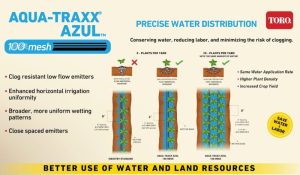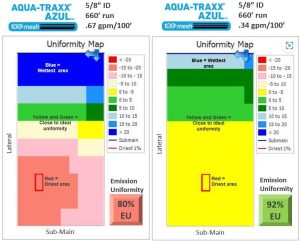 Closely spaced drip tape emitters can enhance salt management for seed germination, leach salts in permanent crops, dilute soil salinity for salt-sensitive crops and manipulate the wetting pattern – all with less cost and more efficiency than widely spaced emitters. But with so many variables in farming applications, how do you know this is the best option? Cal Poly San Luis Obispo’s Drip and Micro Irrigation Design and Management Manual, published by the Irrigation Training and Research Center (ITRC) in 2007, offers the following guidance:
Closely spaced drip tape emitters can enhance salt management for seed germination, leach salts in permanent crops, dilute soil salinity for salt-sensitive crops and manipulate the wetting pattern – all with less cost and more efficiency than widely spaced emitters. But with so many variables in farming applications, how do you know this is the best option? Cal Poly San Luis Obispo’s Drip and Micro Irrigation Design and Management Manual, published by the Irrigation Training and Research Center (ITRC) in 2007, offers the following guidance:
Seed Germination
In more arid areas, widely spaced emitters (such as one tape for every two rows, or emitter spacing greater than 16″) can cause salt buildup between the holes, which will prevent seeds from emerging in these areas. To help push salts away from seeds and enhance germination:
- Use drip tape on the soil’s surface or just a few centimeters below with closely spaced emitters to leach salts downward.
- Shape drip-irrigated beds with an indentation at the high points so that salts accumulate away from the seed line which is planted below the indentation.
Orchards and Vineyards
Drip laterals typically wet less than 40% of the total soil surface, and over time, salts carried to this wetted strip through the irrigation water will safely leach away from the soil close to the emitter. However, salts will concentrate in the soil as distance from the emitter increases. Periodic “reclamation” leaching is needed to remove the salt from these outer zones of the soil.
Using broadcast flood or sprinkler irrigation to leach these concentrated salts below the root zone can be wasteful, since only 20% to 40% of the surface area of the orchard or vineyard needs to be leached. If 100% of the soil area is wet, to treat this 20% to 40% of the area, 2.5 to 5.0 times the necessary leaching water will be applied. Instead, ITRC researchers suggest using a portable drip tape system to “target leach” the orchard or vineyard dripline zone.
Improved Yield
Crop yields typically decrease once the soil salinity reaches a threshold value, and as the soil dries between traditional irrigations, salinity concentration becomes worse. Irrigating frequently with closely spaced emitters can help. In fact, if soil salinity remains dilute, yields can be higher than they would be with the same water quality using sprinklers or furrow irrigation.
Wetting Pattern
Wide spacing of drip emitters in Subsurface Drip Irrigation (SDI) applications requires higher pressure during germination, as well as heavy-wall drip tape to handle the high pressure without damage. Water is also applied to the soil until the surface becomes very wet, often resulting in standing water in furrows. Initial buying costs and post-purchase operation costs will be higher, and soil surface wetting may damage crop quality and/or encourage unwanted weed growth. For optimal performance, closely spaced emitters are often the best choice to achieve the right wetting pattern, increase crop quality and reduce costs compared to wider-spaced emitters.
For more information about the advantages of properly managed drip irrigation systems with closely spaced emitters, visit http://www.itrc.org/, or www.dripirrigation.org.




